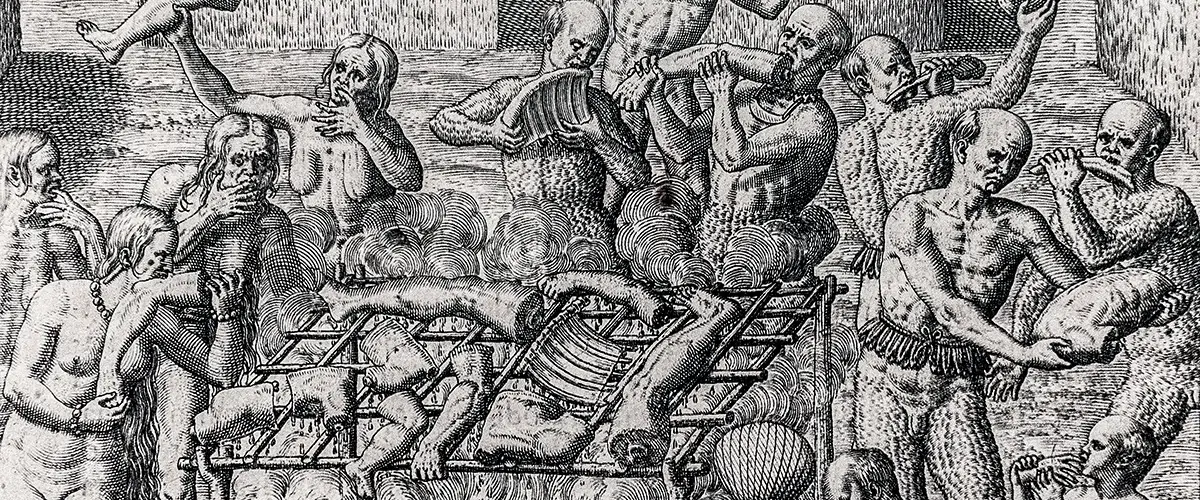Cannibalism. Taboo, horror, disgust – probably the first things that come to mind when thinking of it. Oh, but how fascinating it is! A dark and macabre topic at its best. Below is a quick guide on what (human) cannibalism is all about.
Oh, a quick question to mull over. I think it’s at least partly related to bioethics. If the opportunity presented itself – let’s say, there was a scientific opportunity to grow a small lump of your own flesh for the sole purpose of eating it. Would you? Or would you tell someone to taste it for you? Or do you think I’m being disgusting and should shut up? You decide.
How is cannibalism defined?
Cannibalism is defined as the act of consuming the flesh or internal organs of another individual of the same species. This behaviour is most commonly associated with human beings due to the taboo and often sensationalist element of humans eatings other humans, but it occurs in thousands of other species as well. This article concentrates mostly on human cannibalism.
Is autophagy cannibalism?
There are some other forms of consumption that might seem like cannibalism, but aren’t. For example, autophagy – where cells consume and break down their own components – is not considered cannibalism.
It’s a metabolic process in the human body that occurs in certain conditions such as starvation and in some diseases. It’s also a natural process where cells break down unneeded or damaged components for a sort of housekeeping in the body, for example, during sleep.
Why do people eat people?
In human societies, cannibalism has been practiced for a variety of reasons, including for religious or cultural rituals, as a form of survival, or for psychological reasons. There have been instances of cannibalism throughout history, and it’s still documented in some isolated societies.
Eating the flesh of another person is often associated with severe psychological disorders or extreme circumstances such as famine, war, or some kind of survival situations such as being stranded without means of escape.
Some psychological disorders such as schizophrenia can affect a patient’s ability to think and behave in a normal way. Schizophrenia doesn’t cause cannibalism as a symptom by any means, but in some rare cases the related delusions, hallucinations and disordered thinking have resulted in the patient engaging in cannibalistic behaviour.
What different types of cannibalism are there?
There are several different types of human cannibalism, including:
- Endocannibalism
- Exocannibalism
- Survival cannibalism
- Ritual cannibalism
- Pathological cannibalism
- Necrophagia
- Self-cannibalism
Some instances of cannibalism might be a combination of these different subtypes. For example, cases of necrophagia and self-cannibalism can also fall under pathological cannibalism where the cause of the consumption is coming from a mental disorder.
Endocannibalism
Endocannibalism is the consumption of the flesh or organs of deceased individuals within one’s own cultural or social group as a form of mourning or tribute.
Exocannibalism
Exocannibalism is the opposite of endocannibalism, and means the consumption of the flesh or organs of individuals from another cultural or social group, often as part of a victory celebration or as a way of demonstrating dominance.
Survival cannibalism
When human flesh is consumed in order to survive in extreme circumstances, such as during famines or shipwrecks, it is considered to be survival cannibalism.
Ritual cannibalism
Ritual cannibalism is the consumption of human flesh as part of religious or cultural rituals, often to transfer the spiritual essence or power of the deceased to the consumer.
Pathological cannibalism
Pathological cannibalism means the consumption of human flesh as a result of a psychological disorder, such as schizophrenia or psychosis.
Necrophagia
Necrophagia is the consumption of human flesh from dead bodies, often as a result of a fetish or sexual compulsion.
Self-cannibalism
Self-cannibalism is also called autocannibalism, or autosarcophagy (not to be confused with autophagy mentioned above). It’s a form of cannibalism where you eat yourself, as opposed to eating another individual. It’s considered a mental disorder, and has four main subtypes:
- Pica, or allotriophagia
- Onychophagia
- Dermatophagia
- Rapunzel syndrome, or trichophagia
The history of cannibalism
The history of cannibalism dates back to prehistoric times and has been documented in various cultures and societies all around the world. In many cases, the practice of cannibalism was linked to religious or cultural rituals, and it was believed to have spiritual or supernatural significance.
For example, some Tibetan Buddhists used to practise cannibalism on those who were believed to have been born as Brahmins seven times. Consuming their flesh was to aid the Buddhists to achieve enlightenment.
In some societies, such as the indigenous tribes of the Pacific islands, cannibalism was an integral part of their religious beliefs and was practiced as part of rituals honouring the dead. In others, such as the Aztecs of Mexico, cannibalism was practiced as part of religious sacrifices to the gods. It’s unclear whether it was just for this purpose, or if human flesh was actually part of their normal diet.
In times of famine or extreme hardship, survival cannibalism has been recorded throughout history. For example, during the 1609-10 winter of the “Starving Time” at Jamestown, Virginia, some colonists resorted to cannibalism in order to survive.
In some instances, cannibalism has been used as a means of punishment or as a demonstration of power. For example, in the early modern period, European explorers and colonisers reported instances of cannibalism among the native populations of the Americas. The Mongols have also practised cannibalism, most likely to demonstrate power over their enemies.
Some famous cases of cannibalism
The below are a few of the many documented cases of cannibalism throughout history.
The Donner Party
In 1846, a group of American pioneers became stranded in the Sierra Nevada mountains during the winter and were forced to resort to cannibalism in order to survive.
The Sioux Uprising of 1862
During this conflict in Minnesota, a group of Native American Sioux warriors were accused of cannibalising the bodies of fallen soldiers.
Alexander Pearce
Pearce was an Irish convict, who was transported to Australia in the early 19th century, and was convicted of cannibalism after escaping from a penal colony and surviving in the wilderness by eating his fellow escapees.
Albert Fish
This American serial killer, who was active in the early 20th century, was known for his acts of cannibalism and was dubbed the “Brooklyn Vampire.”
The Uruguayan Air Force Flight 571 crash
In 1972, a plane crash in the Andes Mountains led to the survivors resorting to cannibalism in order to survive. This story was later depicted in the book and movie “Alive.”
Jeffrey Dahmer
Dahmer was an American serial killer, who was active in the late 20th century. He was convicted of 17 murders and was known for his acts of cannibalism and necrophilia.
Robert Maudsley
This British serial killer, who was active in the late 20th century, was dubbed the “Hannibal Lecter of Britain” for his acts of cannibalism while in prison.
Armin Meiwes and Issei Sagawa
In the early 21st century, these two people gained notoriety for their crimes of cannibalism, which they committed for sexual and/or psychological reasons.
Zhang Yongming
This Chinese farmer, who was active in the early 21st century, was convicted of killing and eating more than 20 people in a 10-year span.
The Aghori sect of Hinduism
This is a small sect of Hinduism that still practise cannibalism today. They’re nomads who move around constantly, usually somewhere between the borders of Nepal and India. The sect is known for its practice of cannibalism in some of their religious ceremonies and rituals. They also use human skulls and bones for rituals and jewellery.
Bhagaval Singh and Laila
In October 2022, this couple in India, along with their accomplice who was also a convicted rapist, were arrested for practising cannibalism as part of an esoteric human sacrifice. They beheaded two women after brutally torturing them, and cooked and ate their body parts before burying the corpses on their property.
The motive for this was related to superstitious beliefs. They believed that the more brutal the ritual, the more riches they would attain.
References and further reading
- This Female Photographer Spent A Month With India’s ‘Cannibal Cult’ – Refinery29
- Cannibalism – Encyclopædia Britannica
- When People Ate People, A Strange Disease Emerged – The Salt (about cannibalism among the people in Papua New Guinea)
- Scientists Study 5 Cases of Pathological Cannibalism. Narcissism Partly Explains Heinous Act. – Live Science
- Constantine, N. (2018). A History of Cannibalism: From Ancient Cultures to Survival Stories and Modern Psychopaths
- Yilmaz A, Uyanik E, Balci Şengül MC, Yaylaci S, Karcioglu O, Serinken M. Self-cannibalism: the man who eats himself. West J Emerg Med. 2014 Sep;15(6):701-2. doi: 10.5811/westjem.2014.6.22705. PMID: 25247046; PMCID: PMC4162732.

